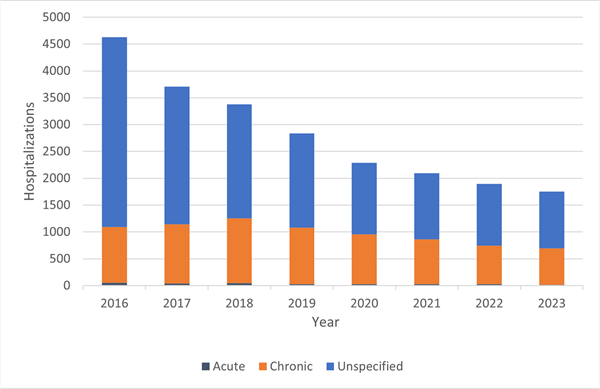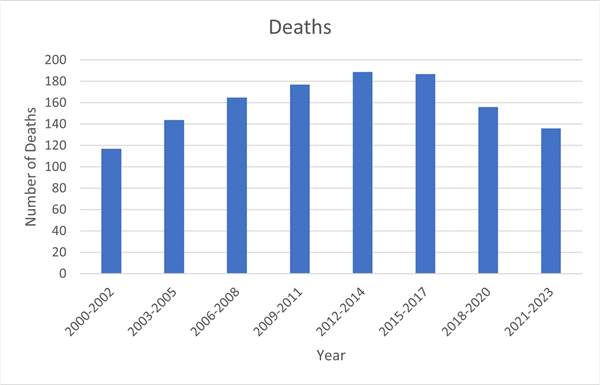Hepatitis C

Introduction
Hepatitis C is a liver disease that results from infection with the hepatitis C virus (HCV), which is spread primarily through contact with the blood of an infected person. Hepatitis C infection can be classified as either “acute” or “chronic.” Cases are referred to as “acute” if the infection is newly acquired. Acute infection generally leads to chronic infection, as only 30% percent of persons clear the infection without treatment.1 HCV, if left untreated, can result in cirrhosis, liver cancer, and death. The Centers for Disease Control and Prevention (CDC) states that today most people become infected with HCV by sharing needles or other equipment to inject drugs. Effective medications are available to treat the disease with few side effects. Treatments usually involve 8-12 weeks of a one-pill-a-day regimen and result in a cure for over 95 percent of infected individuals.2 There currently no vaccine available for HCV.
Acute Hepatitis C
Persons with acute hepatitis C infections often do not have symptoms; however, 20-30% of individuals have mild to severe gastrointestinal symptoms, including jaundice, within six months of infection. Identification of acute cases requires symptom information and laboratory data or evidence of seroconversion. In 2023, 7 cases reported to the Allegheny County Health Department met the revised 2020 acute case definition. Of these, 7 were classified as confirmed acute cases. The CDC reported that in 2022 the number of acute cases nationally decreased by 6% from 2021; this is the first time the number of acute cases has declined in a decade.3
Chronic Hepatitis C
Chronic hepatitis C is associated with liver damage that can lead to liver cancer and failure. The number of newly reported chronic hepatitis C cases in Allegheny County has been decreasing since 2017. The trend from 2022 to 2023 was no exception. The reason for the decrease is uncertain, but may be partially related to the disruption in health care testing services during the COVID-19 pandemic. 4,5 In 2023, there were 573 cases of chronic hepatitis C cases reported in Allegheny County residents. Of that total, 385 (67%) were classified as confirmed chronic cases* and 188 (33%) were classified as probable chronic cases** (Figure 1).
Figure 1 Chronic hepatitis C cases by year and classification, Allegheny County, PA, 2011-2023

Of the 573 confirmed and probable cases in 2023, 372 (65%) were male and 201 (35%) were female. The age distribution was bimodal with peaks in the 30-44 year and 55-64 year-old age groups (Figure 2).
Figure 2. Chronic hepatitis C cases by age group and sex, Allegheny County, PA, 2023

Perinatal Hepatitis C
The hepatitis C virus can be transmitted from an infected mother to her infant at birth, with a transmission rate of about 6%-7%.6,7 Mother-to-child transmission is the leading cause of childhood HCV infection. According to the CDC, the number of infants born to women who are infected with HCV is increasing. The CDC recommends HCV testing during every pregnancy so that infants at risk of infection receive appropriate testing and care. Women with active HCV infections are encouraged to seek treatment prior to becoming pregnant. In 2023, one case of perinatal HCV was reported in Allegheny County.
Hospitalizations Associated with Hepatitis C
Depending on the severity of illness, hepatitis C infection can result in hospitalization. In 2023, 1,754 individuals in Allegheny County were hospitalized with a diagnosis of hepatitis C (either the primary diagnosis or one of up to 17 secondary diagnoses). Of these, 675 (38%) had chronic hepatitis, 17 (1%) had acute hepatitis C, and 1,062 (61%) had hepatitis C with no classification specified (Figure 3).
Figure 3. Hospitalizations with an HCV diagnosis, Allegheny County, PA, 2016-2023

Data source: Pennsylvania Health Care Cost Containment Council
Hepatitis C-related Mortality
In 2023, a total of 34 Allegheny County residents had hepatitis C listed as an underlying or contributing cause on their death certificate. Deaths attributed to hepatitis C have decreased since 2015-2017.
Figure 4. Number of cases with hepatitis C listed as a cause of death, 2000-2023

Data source: CDC Wonder
Hepatitis C Prevention
Hepatitis C is the most common bloodborne infection in the United States. It is spread through exposure to the blood of someone who is infected. Even a small amount of blood is enough for a new infection to occur. Here are steps to prevent infection with HCV:
- Never share needles
-
- People who use intravenous drugs are at highest risk of getting infected with HCV because many share needles
- Avoid direct exposure to blood or blood products
-
- Any tools that encounter blood or draw blood should be disposed of safely or sterilized
- Don’t share personal care items
-
- Sharing razors or toothbrushes can also be a vehicle for viral transmission since small cuts sometimes occur on the skin or gums during use
- Use licensed tattoo and piercing artists
-
- Correct sanitary procedures, such as using new disposable needles and ink wells, should be done for each customer
- Practice safe sex
-
- Learn how at practice safe sex, thus avoiding sexually-transmitted infections, by visiting the CDC’s website.
Resources
References
- World Health Organization (2024). Hepatitis C. November 2024
- Centers for Disease Control and Prevention. Hepatitis C Prevention and Control. November 2024
- Centers for Disease Control and Prevention. Viral Hepatitis Surveillance Report 2022. November 2024
- Barocas JA, Savinkina A, Lodi S, et al. Projected long-term impact of the COVID-19 pandemic on hepatitis C outcomes in the United States: a modelling study. Clin Infect Dis. Published online September 9, 2021. doi:10.1093/cid/ciab779
- Kaufman HW, Bull-Otterson L, Meyer WA, Huang X, Doshani M, Thompson WW et al. Decreases in Hepatitis C Testing and Treatment During the COVID-19 Pandemic. AJPM 2021;61(3): 369-376.
- Benova L, Mohamoud YA, Calvert C, Abu-Raddad LJ. Vertical transmission of hepatitis C virus: systematic review and meta-analysis. Clin Infect Dis 2014;59:765–73.
- Ades AE, Gordon F, Scott K, et al. Overall vertical transmission of HCV, transmission net of clearance, and timing of transmission. Clin Infect Dis 2023;76:905–12.